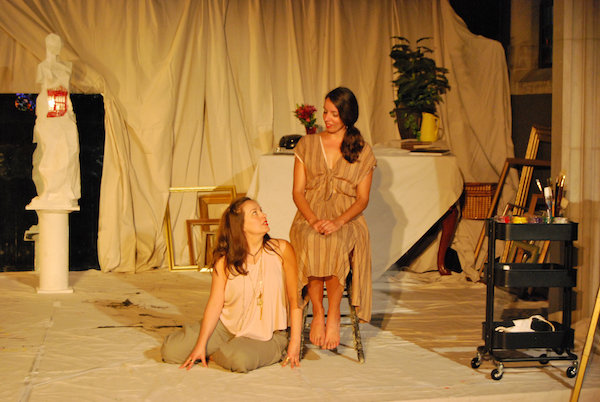
Memory of love, an impulse to punish in 'The Color of August'
By Steve Callahan
The Slightly Askew Theatre Ensemble continues it's "Season of Adaptation" with a production of The Color of August, by famed Spanish playwright Paloma Pedrero. This is a new translation and adaptation by Will Bonfiglio, who is a long-time member of the company.
It's a short play, just an hour long, and it's a two-hander featuring SATE regulars Ellie Schwetye and Rachel Tibbetts. It's directed by the imaginative Lucy Cashion, who also provides the quite beautiful sound design. The play is a frenetic, energy-packed hour. It is sometimes intriguing but often simply overwrought. It's a puzzling piece, fun to think over and analyze, and these two gifted actresses are fiercely invested in it, but in the end there are serious problems with the play and the production.
Maria and Laura grew up together and they came to be profoundly bonded. Whether this love had a sexual element is not clear, but it was passionate. Laura, herself a painter, became Maria's muse and she modeled for a number of Maria's best paintings. But eight years ago something happened to shatter this deep friendship, and the two haven't spoken since. Maria went on to become a highly successful artist, some of her paintings selling for over a million. (Dollars? Pesos?) Laura is now near poverty, failed as a painter, drinking a lot and eking out a living as a model.
As the play opens we meet Maria in her studio in Madrid. She is about to reëngage in that most important relationship of her life. Through an agency, and under a false name, she has hired Laura as a model. When Laura arrives she is startled and angry to learn who has hired her and that Maria brought her here not really to pose but to open up this painful old case -- to somehow reclaim her. The battle begins.
Old wounds are pried open, old love revisited. There is anger and confusion. These two have competed in all things, and now they are competing, somehow, to win . . . something. We learn that Laura had felt used. We learn that Maria envied Laura's breasts. We learn of Laura's lover, John, who abandoned her but with whom she's still obsessed. We learn that Maria's cliché husband ignores her to watch soccer. He occasionally hits her, but she doesn't seem to mind -- not because she loves him, but perhaps just because (thank God) that's not what this play's about. At one point Maria feeds Laura whiskey as if she were feeding a baby milk. The two women strip to their skivvies and indulge in a paint fight, chasing and daubing each other with paint.
Gender and sexuality are important here. The womb is a recurring motif in Maria's paintings -- and she has done a statue -- a lovely, cubist sort of Venus de Milo with an illuminated red bird-cage in her belly. Laura remarks that "If we'd been a man and a woman we wouldn't have destroyed each other." But this is not a play about gender politics.
There is love and loss and punishment in this play. Each urgently punishes the other for the loss of what they shared.
There is shouting of anger. There is much shouting of anger. And there are startlingly abrupt shifts of gear from battle to cuddle -- or vice versa.
And therein lies a major problem in this production. There are changes but no transitions. A number of times one of the characters suddenly and without apparent motivation goes from almost violent hostility to loving vulnerable intimacy -- or the reverse. I have a suspicion that in these instances the script actually does suggest motivation, but we need a moment when something said actually registers and causes this emotional change in the other character. We need silences in which suspicion or doubt or menace or cunning -- or love can breed. But in this production the pace is relentless. We feel that we are merely watching very agile emotional contortionists. Another quarter-hour would be very well-spent on this play.
One other problem is the absence of any sense that this is a Spanish play -- which it is. Now Spain has a particularly vivid cultural history regarding romantic betrayal. Some Spanish plays are quite cosmopolitan and could be set anywhere; others are like Blood Wedding: so intensely Spanish that they really should only be performed by Spanish gypsies. The Color of August, I believe, is not all that cosmopolitan. The all-consuming passion expressed by these two women would be more credible if we set the play firmly in Spain. (Yes, Madrid is mentioned once, but why is Laura's false lover Juan anglicized into "John"?)
Finally, the two actresses have learned both roles. Who plays what is determined by a coin toss by a member of the audience. This is a gimmick in which many famous actors have indulged, and it carries an element of excitement. But it's a risk with undetermined benefits and a very definite cost: swapping roles halves the rehearsal time. Actresses taking on these roles require long and deep study to be able to discover and then express the motivations which are buried in this very complicated script.
So The Color of August is a flawed script and a flawed production, but the intricate script and the sheer dedication of the artists makes it worth seeing. It continues at the Chapel through August 19.


